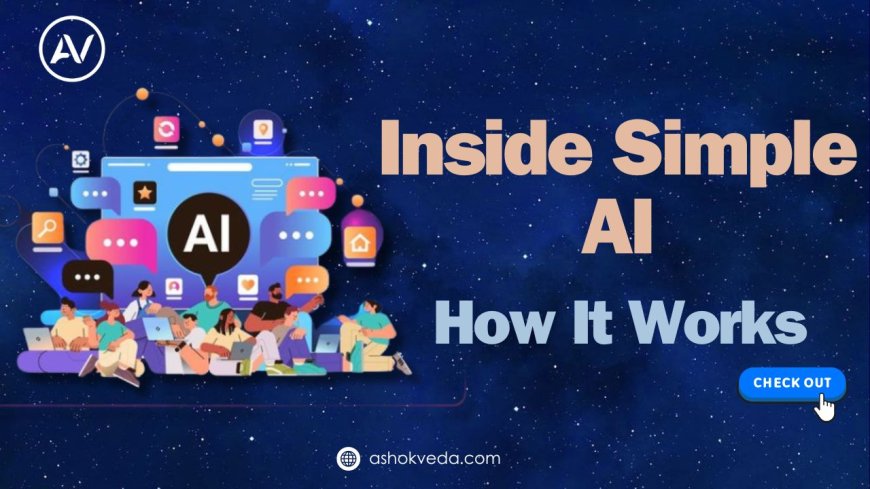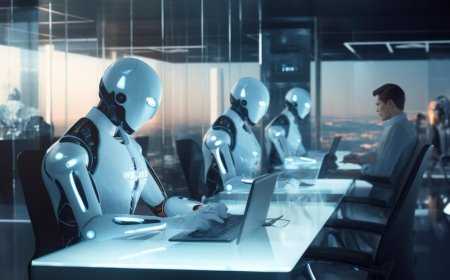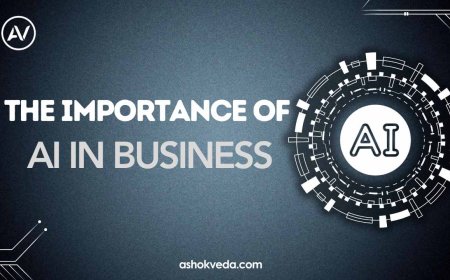How Simple Artificial Intelligence Works
Understand how simple artificial intelligence functions, its core principles, and practical applications. Learn about AI, algorithms, machine learning, and more."

Hey there! Have you ever wondered how simple artificial intelligence works? we'll look at the interesting field of Artificial Intelligence. Simple artificial intelligence, or AI, is all around us. Simple artificial intelligence is silently operating behind the scenes in everything from your favorite streaming service suggestions to your smartphone's voice assistant. Understanding how simple artificial intelligence works can be difficult, so we'll take it down into easy-to-follow sections. and let's put it into the world of simple artificial intelligence and look at how everything comes together.
What is Simple Artificial Intelligence?
Simple artificial intelligence refers to AI systems that perform specific tasks without the difficulties of advanced AI like Machine learning, Deep learning, or neural networks. These systems use algorithms to make decisions and take actions depending on input data. Chatbots, recommendation systems, and basic picture recognition are all examples of applications that use simple AI.
The Basics of Simple Artificial Intelligence
-
Rule-based systems: one of the most basic types of artificial intelligence. These systems function according to a set of created rules. For example, a chatbot may have rules for replying to specific inquiries. If a user asks "What time is it?" the rule-based system returns the current time. This is a fundamental example of simple artificial intelligence in action.
-
Decision Trees: Decision trees are another common method in simple Artificial Intelligence. A decision tree uses a tree-like model of decisions and their possible consequences. Each branch of the tree represents a decision rule, and each leaf represents an outcome. This method is used in various applications, including customer support systems and medical diagnosis tools.
-
Linear Regression: Linear regression is a statistical method used to predict a value based on the relationship between two variables. In simple artificial intelligence, linear regression can help predict outcomes like sales forecasts or risk assessments. It works by finding the best-fit line through a set of data points.
-
Logistic Regression: Logistic regression is similar to linear regression but is used for binary classification tasks. For example, it can predict whether an email is spam or not. It calculates the probability of a certain event occurring by fitting data to a logistic curve.
-
K-Nearest Neighbors (KNN): KNN is a simple, yet powerful algorithm used for classification and regression tasks. It works by finding the 'k' closest data points to a new input and determining its category based on the majority class among those points. This method is often used in recommendation systems and pattern recognition, showcasing the versatility of simple artificial intelligence.
How Simple Artificial Intelligence Works in Everyday Applications
-
Chatbots: Many of the chatbots you see online use simple artificial intelligence. These bots use rule-based algorithms and decision trees to respond to frequently requested inquiries. Chatbots can guide consumers through typical challenges by following a set of planned rules, thereby improving customer service efficiency. AI services and consulting organizations frequently create these systems to improve client interactions.
-
Recommendation Systems: When you receive movie or product recommendations, simple artificial intelligence is often at play. These systems analyze your past behavior and compare it to other users to suggest items you might like. Algorithms like KNN help in identifying similar users and their preferences. AI solutions and AI platforms are integral in building these systems.
-
Spam Filters: Email spam filters use logistic regression to classify incoming emails as spam or not. By analyzing the characteristics of emails and learning from previous examples, these filters can accurately predict which emails are unwanted. This type of AI technology is widely implemented by AI companies focusing on cybersecurity.
-
Voice Assistants: Voice assistants like Siri and Alexa use simple artificial intelligence to understand and respond to basic commands. They rely on rule-based systems and decision trees to interpret your voice commands and perform tasks like setting reminders or playing music. AI software developers play a key role in enhancing these AI applications.
Advantages of Simple Artificial Intelligence
Ease of Implementation: Simple artificial intelligence systems are faster to build than more complex AI systems. They require less computing resources and may be developed more quickly.
-
Cost-Effective: Since they are less complex, simple AI systems are more cost-effective to develop and maintain. This makes them accessible to small businesses and startups. AI outsourcing is a popular option for businesses looking to integrate AI without large upfront costs.
-
Transparency: The decision-making process in simple AI systems is often transparent and easy to understand. This makes it easier to debug and improve the system over time.
Challenges of Simple Artificial Intelligence
-
Limited Scope: Simple artificial intelligence systems are limited to specific tasks and cannot adapt to new tasks without reprogramming.
-
Accuracy: While simple AI can perform well in many applications, it may not achieve the high accuracy levels required for more complex tasks. This is where advanced AI techniques like Machine Learning and Deep Learning excel.
-
Scalability: Simple AI systems might struggle to handle large amounts of data efficiently. As the volume of data increases, the performance of these systems can degrade.
The Future of Simple Artificial Intelligence
-
Integration with IoT: The Internet of Things (IoT) is growing rapidly, and simple AI is playing a crucial role in managing and analyzing data from connected devices. From smart homes to industrial applications, simple AI helps in automating tasks and improving efficiency. AI tools are becoming increasingly sophisticated to handle these integrations.
-
Enhanced User Experience: Simple AI will continue to enhance user experiences across various platforms. Whether it’s more intuitive chatbots, better recommendation systems, or smarter voice assistants, simple AI will make interactions smoother and more personalized. AI marketing is leveraging these enhancements to create more personalized customer experiences.
-
Education and Training: As the demand for AI skills increases, simple artificial intelligence will be a key component of educational programs. Teaching students and professionals about the basics of AI will help them understand and leverage these technologies effectively. AI development courses are now incorporating simple AI as foundational learning.
-
Healthcare Applications: Simple AI is making strides in healthcare, assisting in diagnostics, patient monitoring, and personalized treatment plans. By analyzing patient data, AI systems can provide valuable insights and support medical professionals in their decision-making processes. AI implementations in healthcare are revolutionizing patient care.
-
Sustainability and Energy Efficiency: Simple AI is being used to optimize energy consumption and promote sustainability. From smart grids to energy-efficient buildings, AI systems can help reduce waste and improve resource management. AI strategy plays a key role in deploying these sustainable solutions.
Particle Applications of Simple Artificial Intelligence
-
Customer Service Chatbots: Many businesses employ chatbots to answer client questions and give support. These chatbots use rule-based algorithms and decision trees to assist customers with typical concerns, resulting in faster response times and more customer satisfaction.
-
Personalized Recommendations: Streaming services like Netflix and music platforms like Spotify employ simple AI to suggest content based on customer preferences. These platforms can recommend movies, shows, and songs based on their users' viewing and listening habits.
-
Smart Home Devices: Devices such as smart thermostats and lighting systems employ simple artificial intelligence to learn user preferences and automatically modify settings. This not only improves convenience but also increases energy efficiency.
Understanding how simple artificial intelligence works is important in Simple AI is making our lives easier and more efficient, with chatbots and recommendation systems, spam filters, and voice assistants among its applications. These systems easily and correctly perform certain tasks through the use of basic algorithms and procedures. While they have limitations, the future of basic artificial intelligence seems bright, with ongoing advances promising even more innovative uses.
whether you're a business owner, a student, or simply someone with an interest, understanding basic AI can open up a world of possibilities. Experience the future of simple artificial intelligence and see how it may improve your daily life!




































